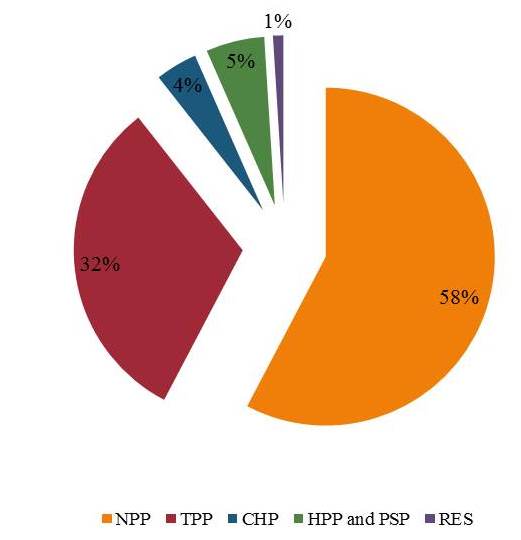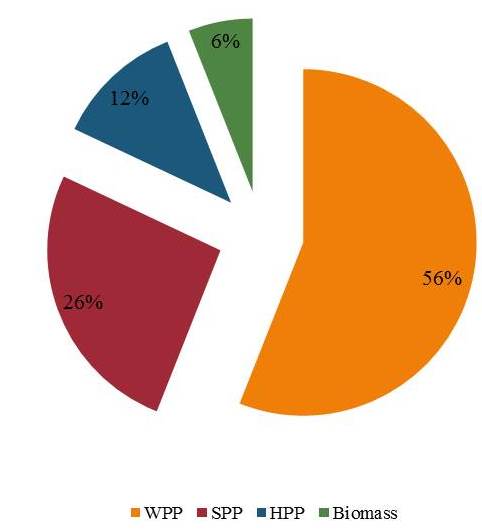With the aim of investing in renewable energy projects in Ukraine we suggest to consider the basic principles of the functioning of the energy sector of the country.
1) General condition
Electricity in Ukraine is produced by nuclear power (51%), heat (37%), hydroelectric and other energy sources (12%). Availability of domestic coal is estimated at 92%, oil – at 18%, natural gas – at 22%.
Nuclear fuel is almost entirely imported. The share of own resources in fuel and energy balance of Ukraine is almost 50%.
Structure of generation of the Interconnected Power System of Ukraine (IPS) (as of 05/05/2015)
NPP (Nuclear Power Plants) – 57.7%;
TPP (Thermal Power Plants) – 31.7%;
CHP (Combined Heat and Power Plants) – 4%;
HPP (Hydroelectric Power Plants) and PSP (Pumped Storage Power Plants) – 5,6%;
Renewable energy sources (RES) - 1%.
Structure of generation of the Interconnected Power System of Ukraine
(IPS) (as of 05.05.2015)

Experts affirm that technically achievable energy potential of the renewable energy sources of Ukraine reaches 50% of the total energy consumption.
For now Ukraine hardly uses these features. The share of renewable energy is 1% only. Its main sources are wind, solar, geothermal energy, energy of rivers, biomass, environmental energy with the use of heat pumps.
The structure of the Renewable Energy of Ukraine
(as of November 2015)

In recent years the solar power plants (SPP) have been developing the most while new wind power plants capacities in Ukraine in 2015 have slowed down almost by 8 times because of the Crimea annexation and prolonged combat operations in Donbas.
However Ukraine pledged to increase the proportion of "green" generation to 11% by 2020.
2) The subjects of the electric-power sector in Ukraine
The functioning of Ukrainian energy market is provided by the following subjects:

Ministry of Energy and Coal Industry is a main authority in the forming and realization of state policy in the electric power, nuclear industry, coal industry, peat extraction and oil-and-gas complexes.
SE "Energorynok" – State Enterprise which made the purchase of all electricity produced by power plants, and its entire wholesale.
SE "NEC" Ukrenergo" is a centralized dispatching system of operative-technological management of production, transmission, distribution and supply of electricity (system operator).
State Inspection on Energy Supervision – state organization which oversees energy consumption regimes to organize a stable operation of Interconnected Power System of Ukraine and develops a methodology of collection and analysis of information needed for forecasts of consumption in short and long term.
The National Commission for State regulation in Energy and Utilities (NERC) – organization of state regulation of activities in the energy and utilities which promotes the development of competition in the sector and the effective organization of the electricity market.
Power Supply Organization (oblenergo) – energy company that specializes in supplying and transmission of electricity to consumers in Ukraine.
The main functions:
- transmission, supply and sale of electric energy
- operation of power lines, substations and other electrical equipment
- design, construction, expansion, reconstruction, technical upgrading and capital repair of electrical networks
Project organization – performs works on manufacturing of design and estimate documentation and accomplishes its approval in the concerned organizations
Construction organization performs construction, reconstruction, capital repair of facilities and installation of equipment.
3) Basic legislation
The main legislation act which regulates the whole electric power sector of Ukraine is the Law of Ukraine "On Electric Power Industry".
http://zakon5.rada.gov.ua/laws/show/575/97-%D0%B2%D1%80/print1443702543251229
This law defines the legal, economic and organizational basis for activities in the energy and regulates relations connected with the production, transmission, distribution, supply and energy use.
Taken into account the fact that the state policy in the electric power is based on the principle of promoting renewable energy, a "green" tariff was established in 2009 for power plants which generate electricity from alternative energy sources.
The term of "green" tariff provided for 2030.
Alternative sources to which a "green" tariff is established include:
• solar energy;
• wind energy;
• biomass;
• biogas;
• micro, mini and small hydropower plants;
• geothermal energy.
The "green" tariff is determined for each alternative source separately.
It’s worth to pay attention to the fact that the power plants which run on alternative energy sources may use an equipment of any manufacturer.
Besides, as a bonus, in case of use the equipment of Ukrainian production is provided the allowance to the "green" tariff in the range of 5 to 10% by 2025.
Also there is a peg "green" tariff to the euro in order to protect investors against inflation risks.
At the state level the power plants are provided with payment in full of all electricity produced using alternative energy sources (http://iknet.com.ua/en/energy-licensing-tariffs/).
In particular, the Wholesale Electricity Market (WEM) in each accounting period must buy from businesses, working under the "green" tariff, and make full payment for the electricity generated from alternative energy sources for "green "tariff allowances given to him.
It should be noted that the scheme of purchase and settlements under the "green" tariff is approved by the The National Commission for State regulation in Energy and Utilities.
4) The main stages of a business project
A distinctive feature of obtaining a "green" tariff in Ukraine if compared with other countries is that the tariff is only possible to be received after full completion of the power plant which provides a generation of alternative sources of energy with connecting it to the network and obtain a license for electricity production.
That is, to get a "green" tariff is only possible after passing all stages of the business project.
The average payback period of alternative energy projects in Ukraine is 4 years.
The main stages of a business project and a summary of each of them:

Audit of energy projects performes with the aim of the analysis of existing documents, land lot research, the analysis of the legislative framework, the analysis of existing networks of power supply, the analysis of potential sources of alternative energy and basic equipment selection.
The project concept includes a consideration of possible project scenarios (for its main technical and economic indices), determines the conditions of the project implementation in accordance with current legislation in the energy sector, determines the potential opportunities and risks of the project, review of markets for electrical/thermal energy and also appropriate safeguards and the assessment to ensure sufficient conditions for optimal generating facility (logistics and support infrastructure) for potential investors, determining the optimal algorithm for the project implementation, taking into account the possibility of using simplified procedures, optimize costs and timing of the project.
The business plan is needed to attract the investments in the project (bank loans, equity investors and other sources of funding). In addition, the development of the business plan includes a tariff model for calculating the tariff for electricity/heat.
Design and construction work – execution of design works, construction and commissioning in the terms provided by the investor.
Licensing and tariffication - this stage involves obtaining a license to produce electricity from NERC, the tariff calculation models and adoption of "green" tariff.
The execution of the Electicity Sale Contract with Energorynok - obtaining proceeds from the sale of produced electricity.
5) Conclusions
Among all CIS countries and many Asian states, Ukraine is the only country which has created favorable conditions for the development of business projects such as construction of power plants which generate electricity from alternative energy sources.
Currently 132 units have already obtained a "green" tariff guaranteed by the state. It should be noted that a "green" tariff in Ukraine is one of the highest among the European countries.
In recent years Ukraine has progressed in improving the procedures for implementing renewable energy projects.
In particular, the alteration to the current legislation of Ukraine helped to ensure reliable and sustainable foundation for the implementation of alternative energy business projects of the country.
Removing of mandatory compliance of the local component demands in the structure of the "green" tariff provided an opportunity to freely choose a power plant equipment for investor.
An expansion of alternative energy sources list under the "green" tariff has provided the ability to select the most economically feasible option for investments.


